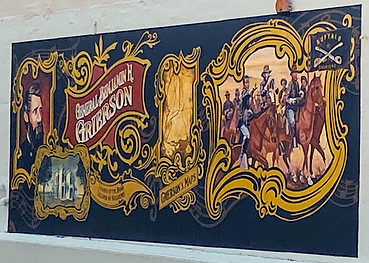
Wall Dog Murals
During the Summer of 2006 and 2019, Jacksonville Main Street hosted professional sign painters from around the world called Letterheads or Walldogs to develop heritage-based public art projects throughout the historic central business district. The result was a collection of murals that highlight Jacksonville’s rich history. The murals were created and installed during week-long events, dubbed “The Jacksonville Walldog Extravaganza” in 2006 and “Wham Bam Mural Jam” in 2019. The Four Corner Churches was a digital addition commissioned by a private individual in 2010 and is not a painted mural. Jacksonville Main Street continues adding to the collection over the years.


01
Eli Bridge Co.
William E. Sullivan became fascinated with the Ferris wheel at the Columbian Exposition in Chicago in 1893. Mr. Sullivan owned a bridge building company, Eli Bridge Co., but in 1900 decided to begin building portable Ferris wheels instead of bridges. The first “Big Eli Wheel” debuted in Jacksonville’s Central Park in May 1900. The company moved its operations from Roodhouse to Jacksonville in 1919, and continues to innovate new rides and products today.
02
West-side public Square 1910
The mural depicts the west side of the public square around 1910, shortly before the construction of the Ayers National Bank tower, now occupied by The Farmers State Bank and Trust Company. The mural also depicts the streetcars, that originally were pulled by horses, and were later replaced with electric vehicles.


03
General Benjamin Grierson
Jacksonville’s Civil War hero, Benjamin H. Grierson, is best known as the leader of a 600-mile Union cavalry raid through the Confederacy in the spring of 1863. In recognition of his accomplishment, President Abraham Lincoln promoted Col. Grierson to brigadier general. After the war, Gen.
Grierson spent nearly 25 years fighting Indians in the Southwest. He died in 1911 and is buried in Jacksonville East Cemetery.
04
Lincoln in Jacksonville
Attorney Abraham Lincoln handled many legal cases in Morgan County courts between the late 1830s and the late 1850s, and gave several speeches in Jacksonville. Prior to the Civil War in 1854, Mr. Lincoln made a fervent antislavery speech in the Courthouse Park, as Central Park was known in the town’s early days. The Morgan County Courthouse was located in the parks SW corner from 1830 to the late 1860s.


05
Buffalo Bill
Buffalo Bill’s Wild West and Congress of Rough Riders of the World traveling show, made at least five visits to Jacksonville between 1876 and 1911. Buffalo Bill is also known to have stopped at J. Capps & Sons’ textile and clothing factory in Jacksonville in the early 1900s to buy colorful blankets covered with traditional American Indian designs.
06
Welcome to Downtown Jacksonville
On March 10, 1825, Johnston Shelton, the county surveyor, laid out a five acre public square in a 160 acre tract. The first of these - an east/west road -was to run from Springfield west to the Illinois River at Naples. This
became State Street. The north/south road became Main Street and the town developed in square blocks from the intersection of these streets.



07
Jacksonville Public Library
Philanthropist and steel empire founder Andrew Carnegie gave Jacksonville citizens $40,000 toward the construction of the Jacksonville Public Library, which officially opened on Feb. 23, 1903. The image on the front door is a gold-leaf image of Mr. Carnegie, with a filigree border.
08
DX Service Station
The Southwest corner of South Main Street and West College Avenue was home to several gasoline service stations. After World War II, DX service stations occupied the location for about 15 years. The 3 paintings depict advertising imagery from the DX stations.



09
Mullenix & Hamilton's
Hamilton’s began in 1913 when Robert Mullenix and Lloyd “Doc” Hamilton, a candy maker by trade, opened a confectionery on East State. Hamilton’s grew into a major full-service restaurant in downtown Jacksonville. Today, Hamilton’s operates a catering business and a banquet hall.
10
Cigar Industry/Short horn label
Cigar making flourished in the late 1800s and early 1900s. The illustration used is an early 20th-century cigar box label of the Cassell firm. Inexplicably, the Cassell name was spelled incorrectly on the original label.


11
Grant's March
Col. Ulysses S. Grant’s march went through the city in July 1861, from Springfield to Quincy. Soldiers could have taken a train, but Grant felt they needed to be ready for war, so he decided to march the troops, and camp in Jacksonville.
12
Four Corner Churches
This is not a Wall Dog mural, but a vinyl printed picture located outside the Jacksonville Main Street District depicting an iconic local image. For many years, the intersection of Church and State Streets boasted a church on each of its four corners. The landmark ceased to exist in 1966 when an arsonist burned the First Baptist Church on the NW corner. The State Street Presbyterian church was torn down in 1968.


13
Dr. Alonzo Kenniebrew
Located on the east wall of Lincoln Land Community College — is of Dr. Alonzo Kenniebrew, the first African American physician in the U.S. to build and operate a surgical hospital. The hospital was located at 323 W. Morgan St. from 1909 to 1927.

